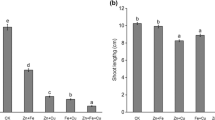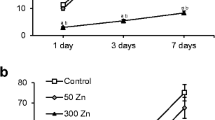Abstract
Effects of different zinc concentrations on antioxidant responses in the roots of the hyperaccumulating ecotype (HE) and nonhyperaccumulating ecotype (NHE) of Sedum alfredii Hance were investigated under hydroponic conditions. Growth of NHE was inhibited significantly when Zn concentration was >-50 μM, whereas high Zn concentrations were beneficial for HE growth, and 500 μM Zn induced a significant increase in the root biomass and reducing activity. Malondialdehyde content and electrical conductivity of the NHE roots increased significantly; however, no changes were observed in HE when the Zn concentration was >10 μM, suggesting a severe damage to the membrane of the NHE roots. Proline content in NHE roots increased rapidly, whereas it was low in HE roots even at high Zn concentrations, suggesting that proline may not play an important role in Zn hyperaccumulation. The activities of superoxide dismutase (SOD), catalase (CAT), ascorbate peroxidase (APX), and guaiacol peroxidase (GPX) in NHE roots increased significantly when the Zn concentration was >10 μM and decreased sharply when the Zn concentration was >-500 μM. For roots of HE, in contrast, no significant changes were observed in SOD, CAT, APX, and GPX activities at low Zn concentrations, whereas a high Zn concentration (≥500 μM) led to a marked enzyme activation, which was in accordance with Zn accumulation in shoots. The results suggest that antioxidant enzymes were important for Zn detoxification in NHE at low Zn concentrations (10–250 μM) and were more critical for Zn detoxification and hyperaccumulation in HE under elevated Zn concentrations (500–1000 μM).
Similar content being viewed by others
Abbreviations
- APX:
-
ascorbate peroxidase
- CAT:
-
catalase
- DTT:
-
dithiothreitol
- GPX:
-
guaiacol peroxidase
- MDA:
-
malondialdehyde
- NBT:
-
nitroblue tetrazolium
- PBS:
-
phosphatebuffered saline
- PVP:
-
polyvinylpyrrolidone
- SOD:
-
superoxide dismutase
- TBA:
-
thiobarbituric acid
- TTC:
-
triphenyl tetrazolium chloride
- TPF:
-
triphenyl formazan
References
Cakmak, I. and Marschner, H., Effect of Zn Nutritional Status on Activities of Superoxide Radical and Hydrogen Peroxide Scavenging Enzymes in Bean Leaves, Plant Soil, 1993, vol. 155, pp. 127–130.
Ebbs, S.D. and Kochian, L.V., Toxicity of Zinc and Copper to Brassica Species: Implication for Phytoremediation, J. Environ. Qual., 1997, vol. 26, pp. 776–781.
Prasad, K.V.S.K. and Saradhi, P.P., Effect of Zinc on Free Radical and Proline in Brassica juncea and Cajanus cajan, Phytochemistry, 1995, vol. 39, pp. 45–47.
Nriagu, J.O. and Pacyna, J.M., Quantitative Assessment of Worldwide Contamination of Air, Water and Soils by Trace Metals, Nature, 1988, vol. 333, pp. 134–139.
McGrath, S.P. and Zhao, F.J., Phytoextraction of Metals and Metalloids from Contaminated Soils, Curr. Opin. Biotechnol., 2003, vol. 14, pp. 277–282.
Prasad, M.N.V., Phytoremediation of Metal-Polluted Ecosystems: Hype for Commercialization, Russ. J. Plant Physiol., 2003, vol. 50, pp. 686–700.
Yang, X.E., Li, X.X., and Ni, W.Z., Sedum alfredii Hance–a New Ecotype of Zn-Hyperaccumulator Plant Species Native to China, Chinese Sci. Bull., 2002, vol. 47, pp. 1003–1006.
Yang, X.E., Long, X.X., Ye, H.B., He, Z.L., Calvert, D.V., and Stoffella, P.J., Cadmium Tolerance and Hyperaccumulation in a New Zn-Hyperaccumulating Plant Species (Sedum alfredii Hance), Plant Soil, 2004, vol. 259, pp. 181–189.
Mittler, R., Oxidative Stress, Antioxidants and Stress Tolerance, Trends Plant Sci., 2002, vol. 7, pp. 405–410.
Yan, X., Yu, D., Wang, H.Y., and Wang, J.W., Response of Submerged Plant (Vallisneria spinulosa) Clones to Lead Stress in the Heterogenous Soil, Chemosphere, 2006, vol. 63, pp. 1459–1465.
Shraddha, S., Susan, E., and Dsouza, S.F., Cadmium Accumulation and Its Influence on Lipid Peroxidation and Antioxidative System in an Aquatic Plant Bacopa monnieri L., Chemosphere, 2006, vol. 62, pp. 233–246.
Larson, R.A., The Antioxidants of Higher Plants, Phytochemistry, 1998, vol. 27, pp. 969–978.
Cao, X.D., Lena, Q.M., and Tu, C., Antioxidative Responses to Arsenic in the Arsenic Hyperaccumulator Chinese Brake Fern (Pteris vittata L.), Environ. Pollut., 2004, vol. 128, pp. 317–325.
Devi, S.R. and Prasad, M.N.V., Antioxidant Capacity of Brassica juncea Plants Exposed to Elevated Levels of Copper, Russ. J. Plant Physiol., 2005, vol. 52, pp. 205–208.
Li, T.Q., Yang, X.E., He, Z.L., and Yang, J.Y., Root Morphology and Zn2+ Uptake Kinetics of the Zn Hyperaccumulator of Sedum alfredii Hance, J. Int. Plant Biol., 2005, vol. 47, pp. 927–934.
Yang, X.E., Li, T.Q., Yang, J.C., He, Z.L., Lu, L.L., and Meng, F.H., Zinc Compartmentation in Root, Transport into Xylem, and Absorption into Leaf Cells in the Hyperaccumulating Species of Sedum alfredii Hance, Planta, 2006, vol. 224, pp. 185–195.
Nanjo, T.M., Kobayashi, Y., Yoshiba, Y., Kakubar, Y., Yamaguchi, K., and Shinozaki, M., Antisense Supression of the Proline Degradation Improves Tolerance to Freezing and Salinity in Arabidopsis thaliana, FEBS Lett., 1999, vol. 461, pp. 205–210.
Heath, R.L. and Packer, L., Photoperoxidation in Isolated Chloroplasts. I. Kinetic and Stoichiometry of Fatty Acid Peroxidation, Arch. Biochem. Biophys., 1968, vol. 125, pp. 189–198.
Bates, L.S., Waldren, R.P., and Teare, I.D., Rapid Determination of Free Proline for Water Stress Studies, Plant Soil, 1973, vol. 39, pp. 205–207.
Nishikimi, M. and Rao, N.A., The Occurrence of Superoxide Anion in the Reaction of Reduced Phenazine Methosulphate and Molecular Oxygen, Biochem. Biophys. Res. Commun., 1972, vol. 48, pp. 849–854.
Fu, J. and Huang, B., Involvement of Antioxidants and Lipid Peroxidation in the Adaptation of Two Cool Season Grasses to Localized Drought Stress, Environ. Exp. Bot., 2001, vol. 45, pp. 105–114.
Koricheva, J., Roy, S., Vranjic, J.A., Haukioja, E., Hughes, P.R., and Hanninen, O., Antioxidant Responses to Simulated Acid Rain and Heavy Metal Deposition in Birch Seedlings, Environ. Pollut., 1997, vol. 95, pp. 249–258.
Andrew, A., Meharg, Mechanisms of Plant Resistance to Metal and Metalloid Ions and Potential Biotechnological Applications, Plant Soil, 2005, vol. 274, pp. 163–174.
Ernst, W.H.O., Verkleij, J.A.C., and Schat, H., Metal Tolerance in Plants, Acta Bot. Neerl., 1992, vol. 41, pp. 229–248.
Patra, J. and Panda, B.B., A Comparison of Biochemical Responses to Oxidative and Metal Stress in Seedlings of Barley, Hordeum vulgare L., Environ. Pollut., 1998, vol. 101, pp. 99–105.
Dordas, C. and Brown, P.H., Permeability of Boric Acid across Lipid Bilayers and Factors Affecting It, J. Membr. Biol., 2000, vol. 75, pp. 95–105.
Halliwell, B., Oxidative Damage, Lipid Peroxidation and Antioxidant Protection in Chloroplasts, Chem. Phys. Lipids, 1987, vol. 44, pp. 327–340.
Slooten, L., Capiau, K., van Camp, W., van Montagu, M., Sybesma, C., and Inze, D., Factors Affecting the Enhancement of Oxidative Stress Tolerance in Transgenic Tobacco Overexpressing Manganese Superoxide Dismutase in the Chloroplasts, Plant Physiol., 1995, vol. 107, pp. 737–750.
Prasad, M.N.V., Phytochelatin Synthesis and Response of Antioxidants during Cadmium Stress in Bacopa monnieri L., Plant Physiol. Biochem., 2006, vol. 44, pp. 25–37.
Schickler, H. and Caspi, H., Response of Antioxidant Enzymes to Nickel and Cadmium Stress in Hyperaccumulator Plants of the Genus Alyssum, Physiol. Plant., 1999, vol. 105, pp. 39–44.
Author information
Authors and Affiliations
Corresponding author
Additional information
Original Russian Text © T.Q. Li, L.L. Lu, E. Zhu, D.K.Gupta, E. Islam, X.E. Yang, 2008, published in Fiziologiya Rastenii, 2008, Vol. 55, No. 6, pp. 886–894.
This text was submitted by the authors in English.
Rights and permissions
About this article
Cite this article
Li, T.Q., Lu, L.L., Zhu, E. et al. Antioxidant responses in roots of two contrasting Sedum alfredii Hance ecotypes under elevated zinc concentrations. Russ J Plant Physiol 55, 799–807 (2008). https://doi.org/10.1134/S1021443708060095
Received:
Published:
Issue Date:
DOI: https://doi.org/10.1134/S1021443708060095




